Tag Archive: generalization
June 22, 2020
by Carole Zangari -
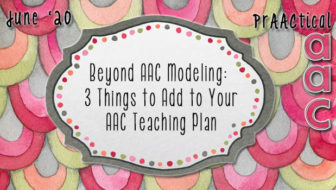
It is hard to overstate the role of aided language input and other forms of AAC modeling when interacting with those who are still developing their language and communication skills. Seeing and hearing others use AAC is important for many reasons. Some AAC users pick up language and AAC skills just through that kind of exposure. Most, however, benefit from explicit instruction on specific skills, such as creating longer and more complex sentences, using morphological endings to change the form of the word, or expanding the range of words they use. They also need support to move from using these skills only during therapy/instruction to using them in a range of functional contexts. Here are some things to add to our intervention to strengthen their AAC learning. Think Aloud Strategy: Narrate the steps of finding what you want to say in their AAC system as you create your message (e..g.,... [Read More...]
Filed under: Featured Posts, PrAACtical Thinking
Tagged With: carryover, generalization, Language Experiences & Activities, Language facilitation strategies, loose training
April 22, 2019
by Carole Zangari -
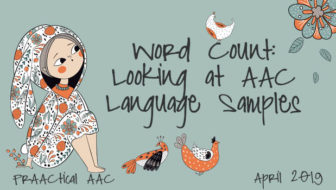
Have you worked with students like these? 19-year-old Jaclyn has used a number of SGDs over the years with a moderate degree of success. Her language is very predictable and the team is concerned that Jaclyn’s progress has stalled. Judging by his progress on IEP goals, 9-year-old Mason has made wonderful strides in learning to use his AAC app. Of the hundreds of words that are available to him, Mason has only ever used about 50 and uses far fewer than that in day-to-day life. Sloan is fairly proficient with her AAC device and can easily answer questions, relay information, and share her thoughts and ideas. Her language is much less sophisticated than her middle school peers, though. While they often integrate some of the academic vocabulary words that they learn in science, language arts, math, and other classes into their conversation and writing, Sloan tends to stick to the... [Read More...]
Filed under: Featured Posts, PrAACtical Thinking
Tagged With: generalization, language sample, lexical diversity, vocabulary
March 21, 2019
by Carole Zangari -
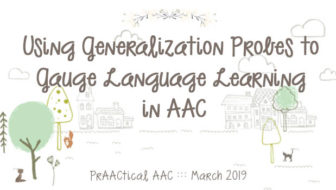
In her role as the team’s SLP, Christy frequently collaborates with classroom teachers to identify areas of language development where students learning AAC need specific goals and instruction. Goals for her students address a range of areas. Given frequent aided language input, Evan will use 2-symbol sentences to make relevant comments at least twice per activity. When presented with preferred and non-preferred options, Sasha will independently request desired activities/objects with 70% accuracy. In the context of peer interactions, Tegan will ask a ‘What’ question in 3 out of 5 opportunities. Given gestural cues, Matthew will converse on a partner-selected topic for at least 4 conversational turns. With visual supports, Gabby will use subject + verb sentences to describe pictures, materials or events in 4 out of 6 trials. To help the students acquire these skills, Christy carefully plans the instructional sequence and selects contexts appropriate for the intervention targets. She... [Read More...]
Filed under: Featured Posts, PrAACtical Thinking
Tagged With: data dollection, generalization, language intervention
April 5, 2018
by Carole Zangari -

Do you work with AAC learners who demonstrate their communication skills in therapy or instructional lessons, but not elsewhere? In this post, we review some things we can do to make it easier for AAC learners to generalize their newly-developed skills and use them in a variety of places with a range of communication partners. Part of the solution to this problem lies in collaborating with the communication partners in other settings. In doing that, we want to be sure that the partners use good communication facilitation strategies, such as these. Partner skills are something we’ve covered here on several occasions. Today, we’ll focus on changes we can make within our direct intervention or instructional lessons with AAC learners. Initially, we may control some of the instructional variables, such as materials and cues, rather tightly. Keeping things consistent is great for the initial teaching of new skills because it allows... [Read More...]
Filed under: Featured Posts, PrAACtical Thinking
Tagged With: AAC intervention, generalization, loose training
December 7, 2017
by Carole Zangari -
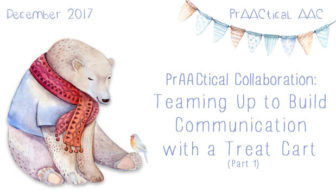
Looking for ways to give your AAC learners the opportunity to communicate with a broader range of communication partners? Interested in practicing AAC skills outside of the classroom? When I saw this fun learning experience that SLP Kimberly Walker and her colleagues developed, I knew it would spark the imaginations of some of our prAACtical friends. I am continually amazed by the creativity of teachers, SLPs, OTs, and others who are passionate about helping students become more proficient with their AAC and language. Based in Colorado, Kimberly works with students in kindergarten through grade 5 at Tarver Elementary. In this post, she explains how they set up a Treat Cart in order to spice up the opportunities for AAC, language, and literacy learning. ——————————————————— Finding ways for our AAC users to see the power of communication by using their AAC device is hard at times. My Occupational Therapist and I... [Read More...]
Filed under: Featured Posts, PrAACtical Thinking
Tagged With: education, generalization, school
October 22, 2015
by Carole Zangari -
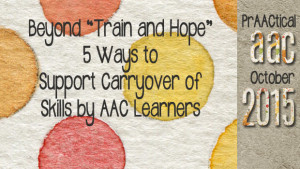
With her SLP, Marissa conjugates verbs and includes function words to make the sentence grammatically correct (e.g., “She is going home with me”). With others, she tends to use her AAC more telegraphically (e.g., “She go home me”). In therapy, Marcus uses his AAC to create 3-4 word sentences. In the classroom, he communicates mostly in single word utterances. Sound familiar? Marcus and Marissa have both learned skills in therapy sessions that they are not using in their daily lives. Data from their therapy sessions show that these students have mastered the target language skills, so the SLP is understandably disappointed when they revert back to using less sophisticated utterances in the classroom. Problems with carryover and skill generalization are not unique to AAC. Ask any SLP who does articulation therapy or teaches kids who stutter how to speak more fluently. Getting them to use the skills demonstrated in... [Read More...]
Filed under: PrAACtical Thinking
Tagged With: carryover, classroom, generalization
October 5, 2013
by Carole Zangari -
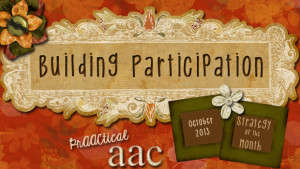
Do you know any of our friends? Jenna can use a talking switch with only a little bit of support. But at calendar time, no one thinks of asking her a question. Hao knows almost two dozen signs and can use a communication wallet with non-signers. But at social gatherings, he’s mostly off to the side playing a game on his iPhone. Isaac uses his SGD capably and can create grammatically correct sentences that include noun phrases and conjunctions. But in Chemistry, his lab group conducts their experiments and writes up the lab report without his contributions. Sienna is able to choose between preferred and non-preferred items in a field of three and is learning to do so in a field of four. But the only time she gets to make a choice is at mealtimes. Like many of you, we put in countless hours helping children and adults who... [Read More...]
Filed under: Strategy of the Month
Tagged With: assessment, classroom, discrepancy analysis, generalization, participation, peer
July 27, 2013
by Carole Zangari -
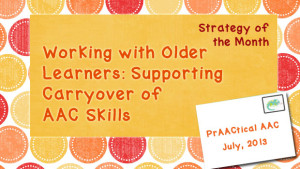
One of the biggest challenges that SLPs face is how to help the communicator use new skills outside the therapy room. Whether the client is someone who stutters, has voice problems, or any other speech-language difficulty, the question is the same: How can we get the client to use skills that were learned and practiced in a therapeutic situation to use those same skills at home, in school, and in the community? It’s an issue with all learners, but for adolescents and adults, we seem to be playing ‘catch up’ all the time. Plus, they are encountering greater numbers of less familiar communication partners and have to fend for themselves more often, making skill generalization even more of a critical topic. Much has been written about problems of generalization by using loose training, and varying the instructional setting, partners, instructions, prompts, and materials. In our way of thinking, it starts... [Read More...]
Filed under: Strategy of the Month
Tagged With: generalization
July 25, 2013
by Carole Zangari -
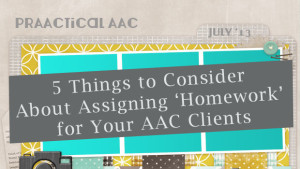
Practicing skills outside of therapy is a good way to extend the learning process and generalize skills to functional environments. It isn’t appropriate for every situation, but when it is, here are some things we try to think about. 1. It should focus on skills they have, not ones they need to learn. Why? Because when we’re learning new things, we get it wrong fairly often. And we don’t want to give them practice getting it wrong. Instead, the home practice should be on things they know and can do, but don’t do consistently. Home practice is a great way to build fluency and automaticity. 2. Tie it into the client’s interests. Use materials or topics that they enjoy. 3. Teach it. Resist the temptation to quickly go over the home practice in the last 60 seconds of therapy or in the waiting room. We’ve all done it, but strive... [Read More...]
Filed under: PrAACtical Thinking
Tagged With: 5, family, generalization, home, homework
January 10, 2013
by Carole Zangari -
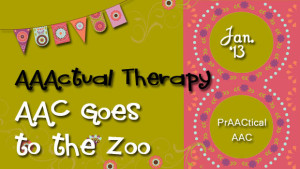
Welcome to AACtual Therapy, a new series on PrAACtical AAC that we’re undertaking in order to give you an up-close-and-personal look at SLPs who ‘do’ AAC. Each of these posts will feature one of our prAACtical friends, some of whom have been AAC interventionists for awhile and others who have come to it more recently. Each one is passionate about giving people a voice no matter what their age or ability level. They’ll be giving us a peek into an AAC therapy lesson that they use, and telling us about the strategies that make it successful. They’ll share a bit about the goals and objectives the lesson was designed to address, and what sorts of AAC their clients are using. Hopefully, we’ll see them in action Here’s what NOT to expect: Perfection. It doesn’t exist, so we don’t even bother looking for it. We’re featuring these clinicians because we want... [Read More...]
Filed under: PrAACtical Thinking
Tagged With: AACtual therapy, generalization, preschool









